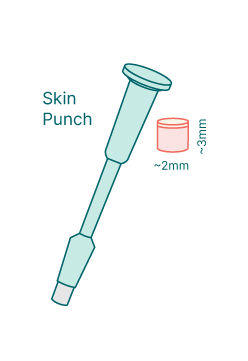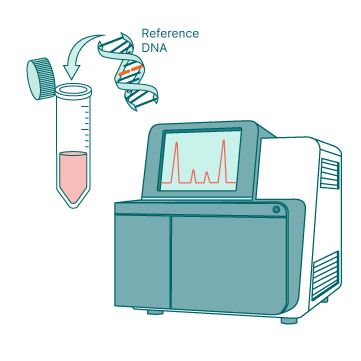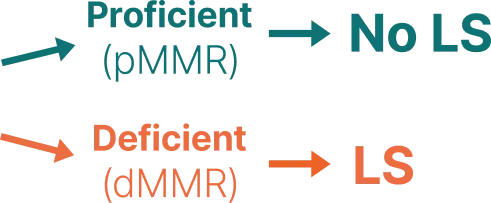Everything You Need to Know About
Lynch Syndrome Testing
Getting tested for Lynch syndrome puts the power in your hands. When you know your genetic risk, you can take action to protect your health and plan for the future.
Tumor studies & DNA sequencing
Genetic testing has come a long way and is one of the main methods of testing for Lynch syndrome today. Testing typically starts with tumor testing and confirming Lynch syndrome through DNA sequencing. However, this method is limited, introducing challenges for patients, their families, and providers:
Accurate results require knowledge and details of the inherited gene mutation.
Diagnosis requires sophisticated and specialized interpretations, which can take a long time.
More than half of suspected Lynch syndrome1 cases remain unclear, and thus without diagnosis.
Testing pathways are limited to the patient with cancer, instead of the entire family.
Get answers, not unclear interpretations
with Lynsight’s test, DiagMMR
Suspected Lynch syndrome cases with unclear results stress the patient, family, and healthcare system with long and expensive interpretations – and often no answer at all. Lynsight simplifies the path to diagnosis with DiagMMR, a reliable test that measures MMR functionality.
Here’s how it works.

Time from sample to interpreted results: 4 weeks
Step 01
Sample
In a quick and simple procedure, skin biopsies are collected from the inner forearm and dissected within 4 days for primary cell culture.

Time from sample to interpreted results: 4 weeks
Step 02
Cell Culture
Cells are transferred to a cell culture flask in humid conditions for adherence and growth. After 14 days of initial growth, cells are trypsinized and expanded in a subsequent culture to approximately 1 × 10^8 cells.

Time from sample to interpreted results: 4 weeks
Step 03
Repair
Cells are collected and treated with cold isotonic and hypotonic buffers before disrupting cell membranes. Nuclei are centrifuged, and then the extracted protein sample is desalted.

Time from sample to interpreted results: 4 weeks
Step 04
Algorithm
To distinguish between MMR proficiency and deficiency, the functional MMR efficiency is assessed through a series of reactions and analyses. Repair efficiency is measured as a percentage of repaired DNA of the total amount of DNA in each reaction.

Time from sample to interpreted results: 4 weeks
Step 05
Result
The test result is quantitative. Interpretations are done based on at least two independent results to ensure accuracy.

Predictive, not reactive
DiagMMR detects MMR deficiency from a minimally invasive, non-malignant tissue sample – before tumors appear.

Functional test
Lynch syndrome testing is done directly on patient cells. Because we extract proteins from patient cells, we don’t need to know the underlying variant.

Actionable results
Interpreting DNA sequencing results can take weeks or months. DiagMMR test results are available in 3-4 weeks and don’t require any interpretation – helping patients and families take their next steps faster.
How to test for Lynch syndrome with DiagMMR
DiagMMR is a test based on more than 25 years of research in the field of Lynch syndrome and the associated inherited cancers. Please get in touch with our team if you have questions or would like to express interest in DiagMMR in your country.

Lynch Syndrome Testing
FAQs
What is Lynch syndrome testing?
Current Lynch syndrome testing based on DNA sequencing aims to identify mutations in specific genes (MLH1, MSH2, MSH6, PMS2, and EPCAM) associated with an increased risk of certain cancers, including colorectal, endometrial, and ovarian cancers.
Who should consider Lynch syndrome testing?
How is Lynch syndrome testing performed?
Testing typically involves a blood, tissue, or saliva sample. The sample is analyzed in a lab to look for genetic mutations linked to Lynch syndrome.
What cancers are associated with Lynch syndrome?
Lynch syndrome increases the risk of colorectal, endometrial, ovarian, stomach, intestine, liver, kidney, brain, and certain skin cancers. The degree of risk varies based on the specific mutation.
What does a positive Lynch syndrome test result mean?
A positive test result means you have a genetic mutation associated with Lynch syndrome, which increases your risk of certain cancers. This doesn’t guarantee you will develop cancer, but you may want to include regular screenings and other preventive measures into your healthcare plan.
What happens if my Lynch syndrome test results are negative?
A negative result means no Lynch syndrome-related mutations were found in the tested genes.
What happens if my Lynch syndrome test results are inconclusive?
Can Lynch syndrome testing help my family members?
Yes, if you test positive, your family members may also carry the mutation. They should consider getting tested to understand their risks and take preventive action.
Is Lynch syndrome testing covered by insurance?
Many insurance plans cover genetic testing for Lynch syndrome if you meet certain criteria, such as having a personal or family history of related cancers. Check with your insurance provider for details.
What should I do if I test positive for Lynch syndrome?

Next steps after Lynch syndrome testing
When you get an answer about Lynch syndrome, you can get a head start on prevention strategies before early signs of cancer. Find your next step today.
Find a path forward
Lynsight offers a new way to test for Lynch syndrome, so healthcare providers can focus on the path instead of the problem. Get in touch today to find out how we can work together.


